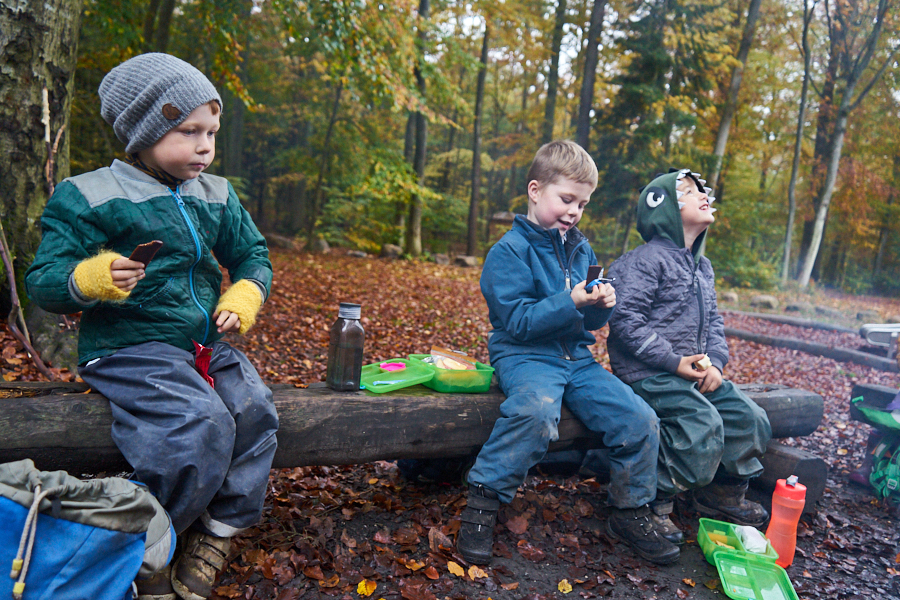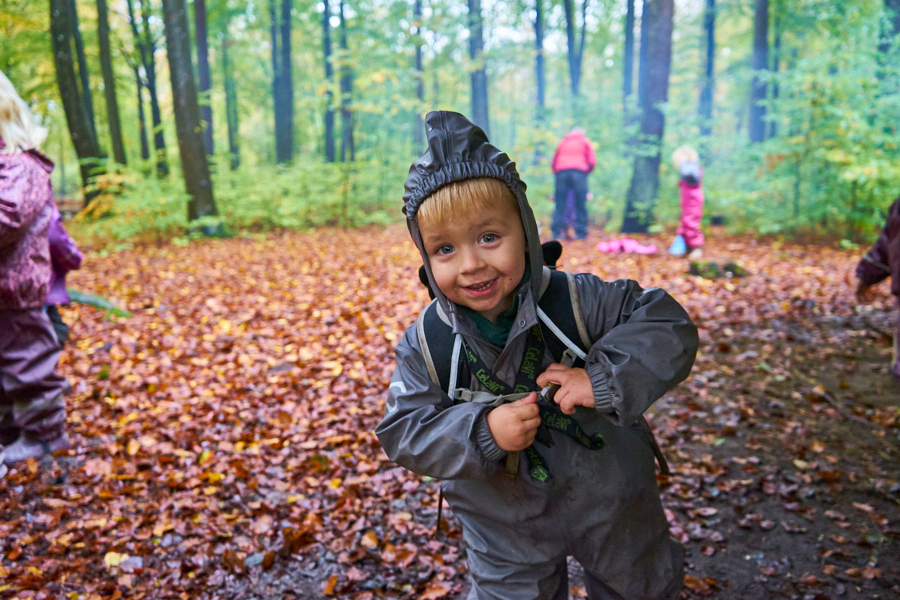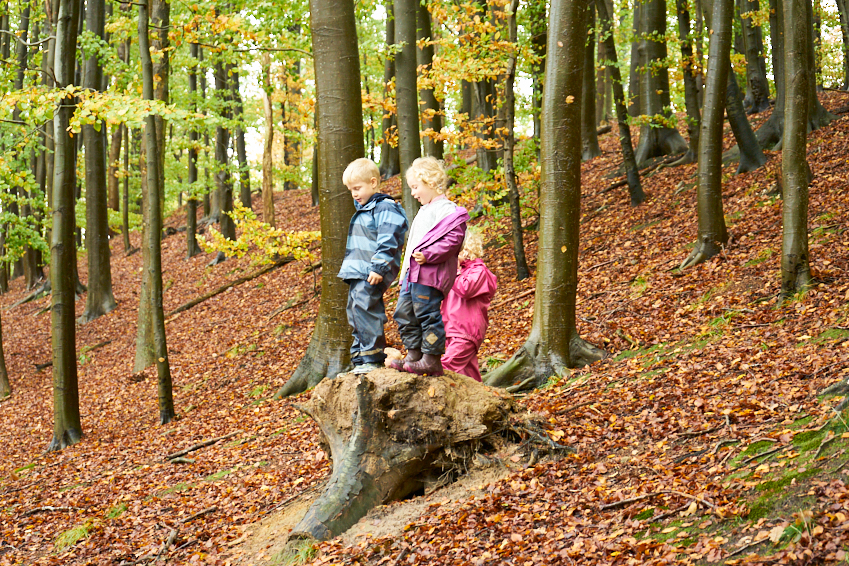At a time when children and their parents are juggling with increasingly busy schedules, when screens are an integral part of our lives and when it is increasingly difficult to distinguish between risk management and overprotection , we have to admit that our children spend less and less time playing freely outdoors and even less in nature. More and more specialists argue that this reality could largely explain obesity and depression in young people as well as the many diagnoses of attention deficit disorder with or without hyperactivity. Faced with these findings, initiatives all the more interesting than the others, are emerging, around the world to help children reconnect with nature. These initiatives are often modeled on the Scandinavian countries, because in these countries it is completely normal for toddlers to spend their day in the middle of the forest, rain or shine. In Denmark, more than 20% of children aged 3 to 6 attend one of the approximately 700 kindergartens in the forest in the country. Today, I invite you to explore one of them. Located in Stenlose on the outskirts of Copenhagen, it has been welcoming toddlers for almost 50 years.

The arrival
Between 7:00 am and 9:00 am, children are welcomed at the base camp, which the educators call home. It is a building containing toilets, a cloakroom, a large room and a large outdoor area with mini-garden, sandbox, outdoor terrace for making small arts projects, small house and wooden pallets that the children transform as they please. There is mud and water everywhere. A fence surrounds the garden, but the door is often wide open and children could easily leave the environment. But they don’t. Charlotte Jensen, the director of the kindergarten, will tell us that it is precisely because the children know that they could do it and know what is on the other side. They therefore do not feel the need to leave, unlike traditional childcare where she has already worked. And since the educators walk around from the inside to the outside to help the children go to the bathroom or put on their seasonal clothes to spend the day outside, the children remain calmly alone in the court, to play with each other, focused on their activities.

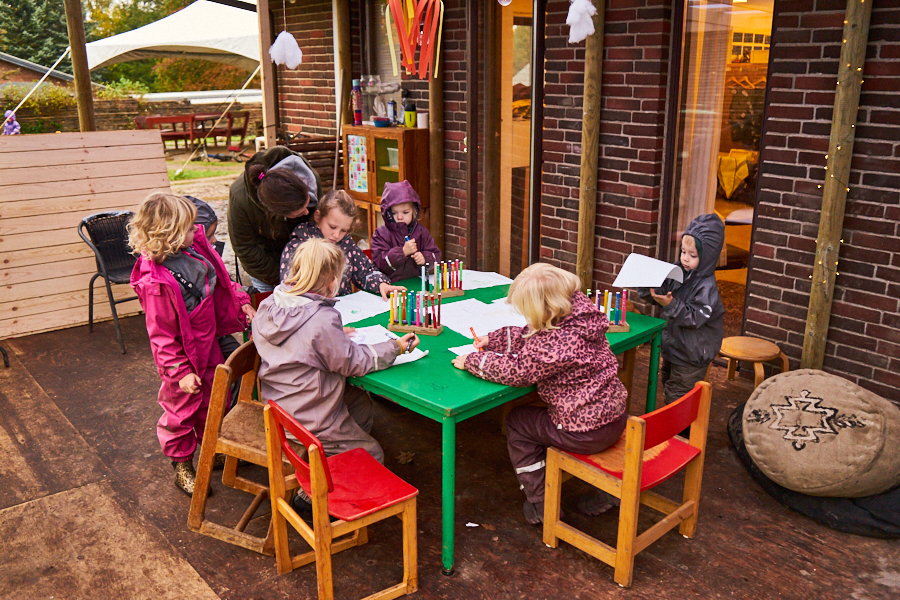
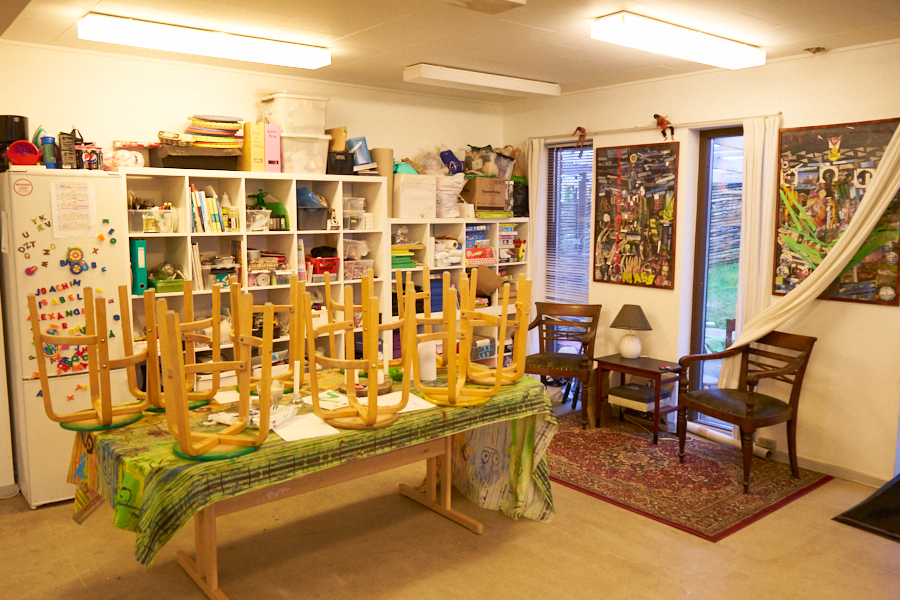


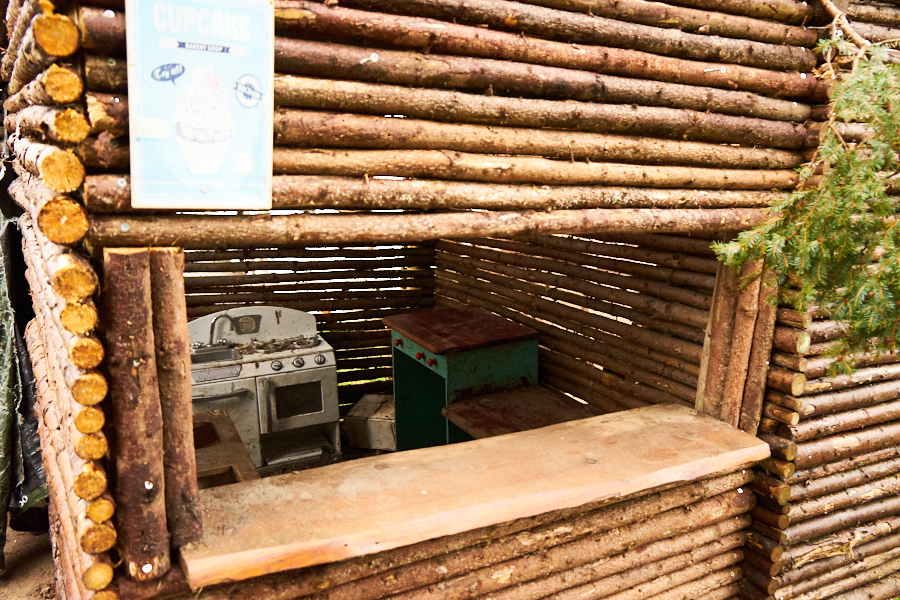
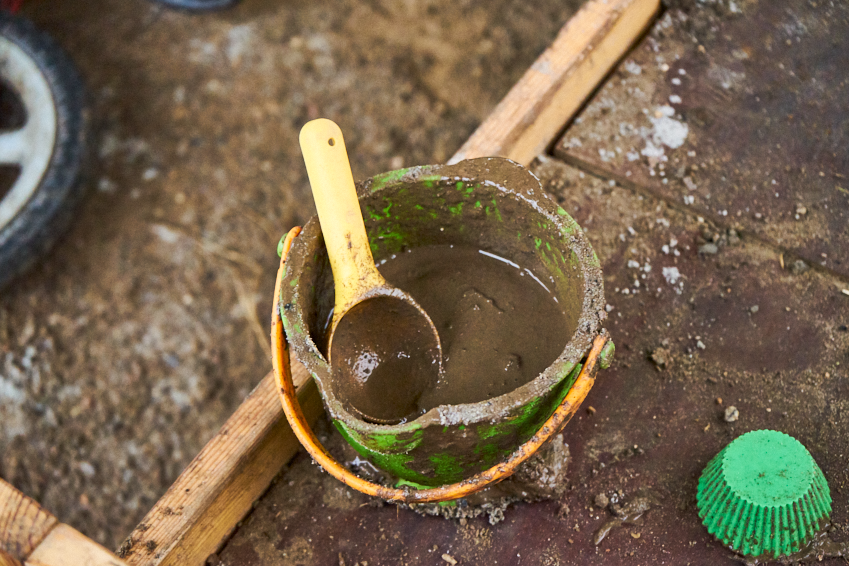
Here, everyone feels welcome, children, as parents, and even the many strangers passing through to visit this extraordinary kindergarten. When we arrived the first morning, educator Jorgen Pedersen, whom everyone calls Akke, had not been notified of our arrival. When we explained the subject of our presence to him, he simply told us that the guests were always welcome here and that it was a pleasure to have us there, and he took the time to introduce us to the children and to explain the course of the day before going to join Victor, 5 years old with whom he was working on the construction of a structure on the ground on which the children can put their backpacks so that it does not drag in the or in the sand while waiting for the departure for the forest. To do this, Victor uses a saw and an electric screwdriver. The educator will take the opportunity to explain to me that here, children are always included in the projects and activities carried out by adults, if they want to participate. Some children are busy making mud blocks, others drawing, others biking or climbing on stacks of wooden pallets. A little boy of just three years old runs, with a stick in his hands longer than him. No one intervenes to demand that they change activities or to worry that they will injure themselves or get dirty. We will quickly learn that adults have full confidence in children’s judgment here and will only intervene if they are in real danger. Here, rain or shine, the children spend the whole day outside, summer and winter. In any case, the interior space would not be large enough for the 31 children to be comfortable there. Because the kindergarten has its own bus, the choices for where to spend the day are great. The wood where we will go, the seaside, the mountains, etc. We choose the most suitable place depending on the temperature and off we go. As it is the autumn holiday week in schools in Denmark and today several children are missing, Pixie, the big sister of Tila, three years old, who also attended this school, asked to come and spend the day there. She is welcomed with open arms by the team. The group today consists of 12 children.
Leaving for the forest

A little before 9am, the second educator, Lene Salling arrives. In a few months, she will be part of the kindergarten team for 25 years. As for the kindergarten, it will celebrate its 50th birthday in the spring, probably making it the oldest in Denmark. His arrival sounds like departure time. Akke, call the kids who are dropping their activities, run up to get their bag and get on the bus that it will take to the woodland where we will spend the day. One of the youngest boys, Elliot, is tired this morning. He cries a little, and doesn’t seem to want to leave the base. Another finds his bag too heavy and does not want to carry it. But here is the rule, everyone is responsible for their own things. After reminding him, the educator will continue on his way confident that Otto will make the right decision. When he arrives on the bus, his teacher will open his bag to show me what it contains and we will realize why it seemed heavier. Otto has two gourds. One of them will stay on the bus for the rest of the day. In addition to this gourd, his bag contains some fruit for his snacks, his midday meal and a water-repellent bag containing spare clothes. It’s basic equipment for everyone. The bus is equipped with child seats and a seat belt. Once all of them are properly installed, the bus leaves the “house” to go to a small forest about 15 minutes’ drive away.

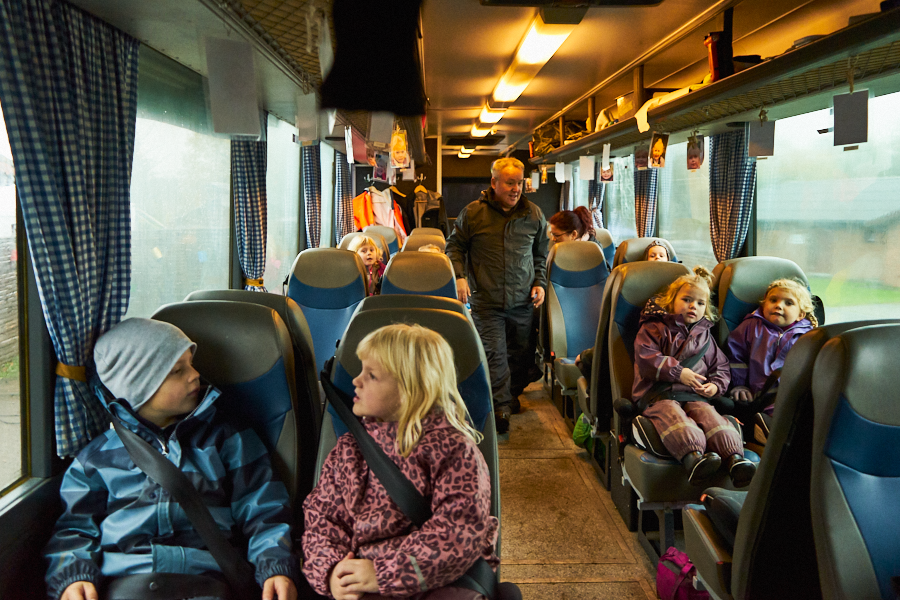
During the trip, Lene will make the call and then take the opportunity to read a story to the children. Elliot will take a nap. Once arrived, everyone will take their bag and get out of the bus before settling along it for the educators to count. It is one of the means used to teach children to count, without them even realizing it. As soon as the count is made, the children go to the covered area on the premises to eat their snack. Today it’s raining. So this little gazebo is welcome to avoid ending up with soggy food.
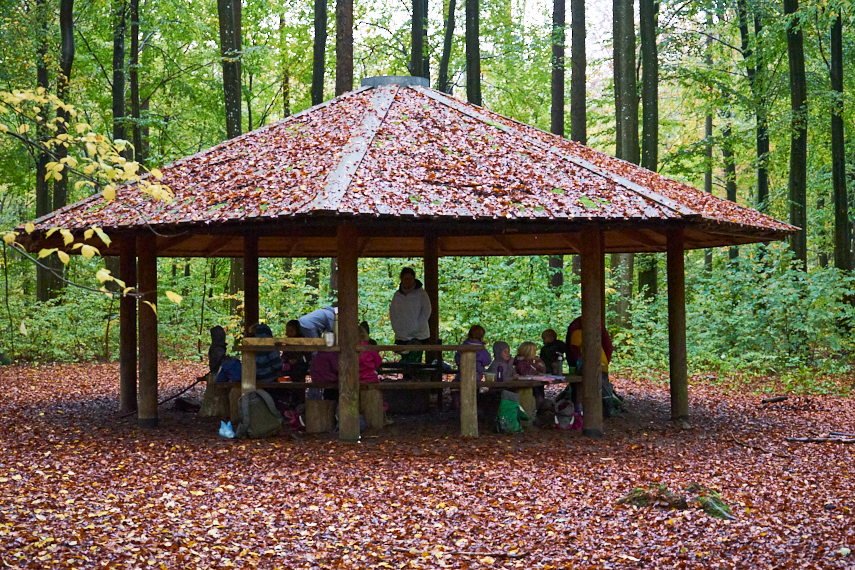
In the center is a foyer. Akke will take the opportunity to start a fire, like every day. It will be used to warm us, but also to cook food, like these chestnuts that we will pick up that morning, and over the days, the children will learn to feed it. It will also take a few minutes to dig a hole in the ground on which will be installed a wooden hole seat. This is what will be used as a toilet for children for the day. The paper they use will be thrown in a bag and they will bring it back. Here, several children still have diapers. Spending the day outdoors, even in winter, often makes toilet training more difficult. But nobody cares. It will come in due time.

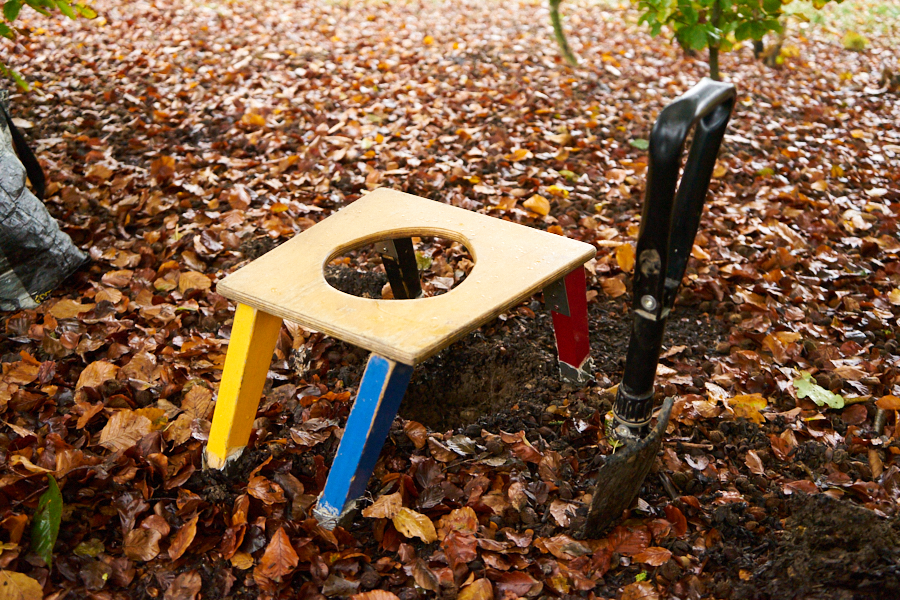
The course of the day and the rules
After the snack, children leave to have fun around the base camp under the supervision of Lene, while Akke offers, to those who wish, to help him build a toy with a large branch that they found by Earth. Today, they will make a “monster truck”. The educator takes out saws of different sizes (depending on their age and skill, they will have one model or the other), then a vegetable peeler so that the three-year-olds can remove the bark on the branch and knives so that the older ones can do the same job. Here too, skill, confidence and age will decide who is entitled to what. No child feels bullied. They know they can use it freely when they have learned how to use it. And educators are confident. Children know how to use these tools and know the safety rules. They can even go to work further if they want to. The only rule will be to bring your tool back to the right place at the end of its activity and to be careful.
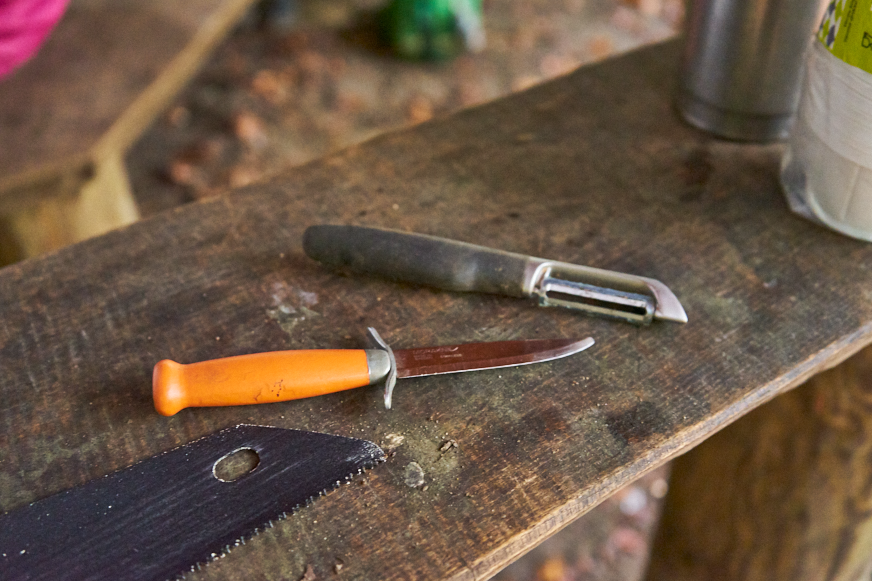
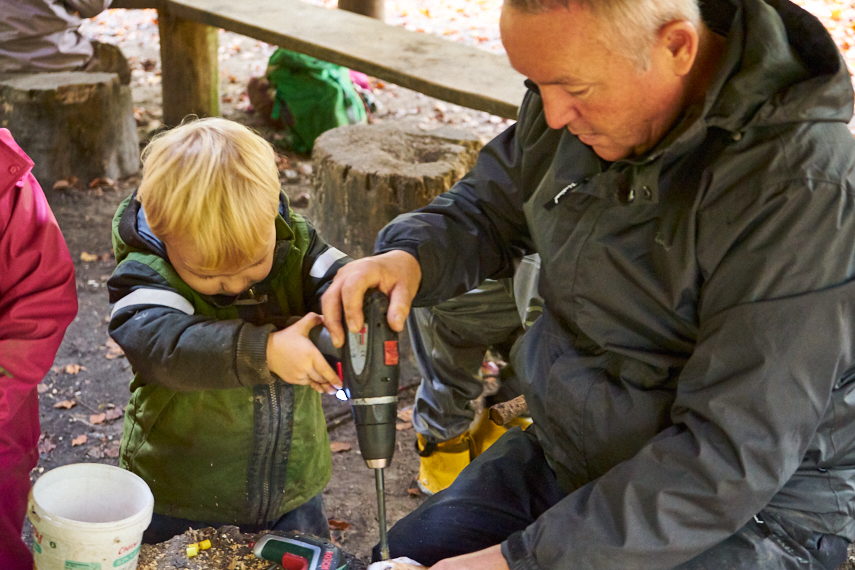
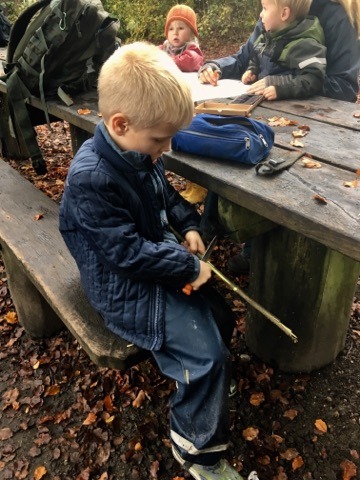
Akke will tell me that few rules exist here. Educators will intervene as needed, but only in case of danger or after observing the situation to make sure you understand what is going on. Sometimes we wait a minute and realize that intervention is not necessary. In Denmark, many species of mushrooms grow in the wood. Some of them are very toxic. Children are therefore not allowed to touch the mushrooms, no matter which one, in order to avoid accidents. Here, we also respect the living. Small animals therefore have nothing to fear from children who will observe them with pleasure, but without hurting them. To have access to a tool or to climb trees, you must have learned how to do it. Once the educators are certain that the child will meet the requirements, they no longer have to ask for permission. And finally, for safety reasons, children have the right to go as far as they want as long as they are always able to see and hear others.
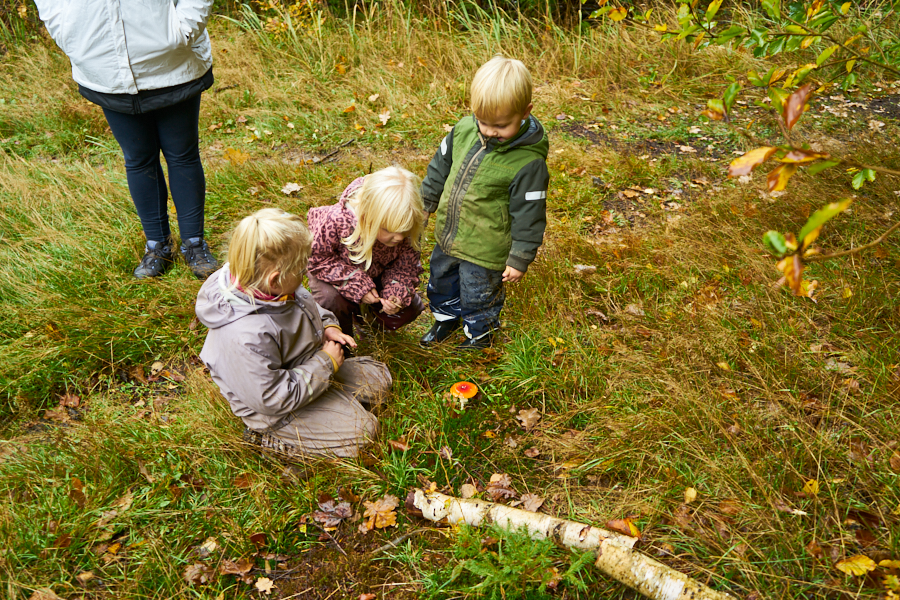
Near the day’s base camp, a makeshift swing designed by Claus Wullf Jensen, another of the educators, with a rope and branch, is hung from a tree. Children take it in turns using a log or sometimes, for the little ones, with the help of another child or Lene, and sways very high. Further on, a fallen tree, under which a child had the idea, a few years ago, of placing a log, serves as a seesaw or a jumping horse. The pieces of wood found on the ground will turn into a sword, a rifle (here, no problem playing with toy weapons), an oar for a boat, a flag or a beam, etc. The puddles of water and mud are not out of bounds. Children jump there with their feet together without anyone trying to dissuade them. In any case, they are dressed accordingly and parents know that their children will come back dirty from the kindergarten. And that’s what is expected of them. Thus, we have proof that they really enjoyed their day.

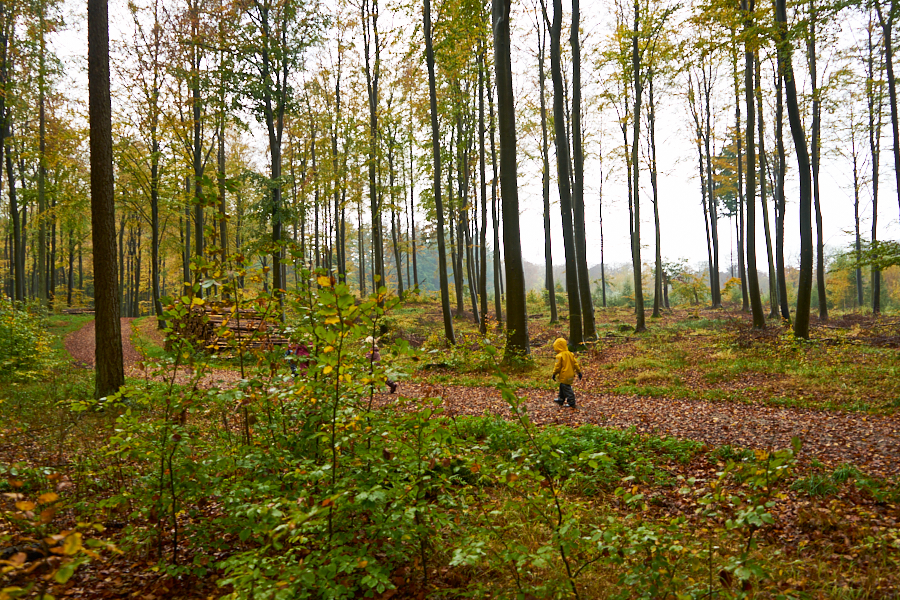
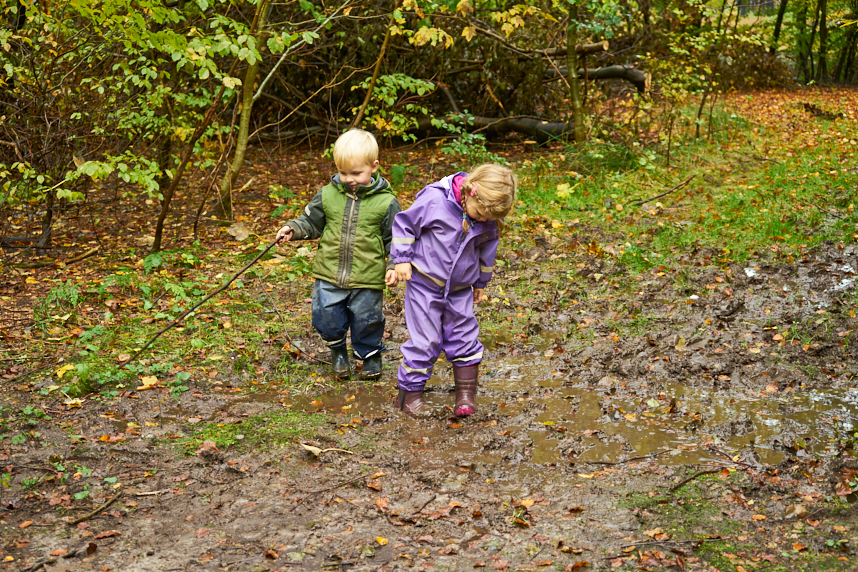
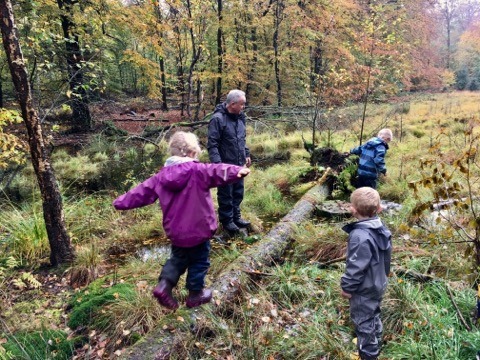
When Akke’s construction project is finished, it’s time for a walk in the woods. The educator explains that they do one almost every day. It allows children, even the most peaceful, to run and move, to make many discoveries (nests, animals, insects, new plants, nuts and small fruits, a swamp, a lake, etc.) and thus, the children understand better the passage of time and seasons since they see their favorite places being transformed from day to day. But before leaving, some moving rhymes are sung. And even if they sing them in Danish, we recognize them easily. And yes, “itsy bitsy spider” and “Head, shoulders, knees, toes” have a Danish version.
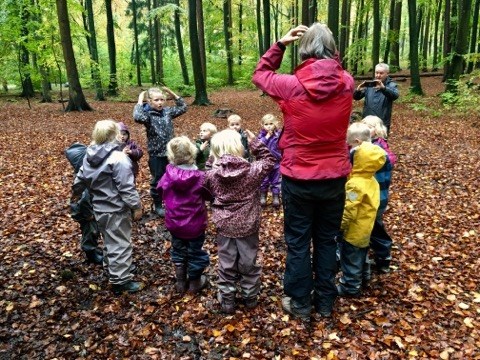
During the walk, they will take us to see the teepees they built with branches, we will learn how to pick chestnuts, we will show you the right places to find blackberries in season or the herbs that we can eat in soup. They will take us to climb on this huge rock that arrived in Denmark during the last ice age, probably coming from Sweden or Norway since it does not exist here. Under it tells us Akke lives one of the trolls that swarm in the country. The children try to wake him up by hitting the rock with their boots. Too bad for us, today, he did not want to show up. They will run from puddle to puddle, climb hills and trees and will not necessarily follow the trails. It’s not necessary. Here, these rules do not exist.

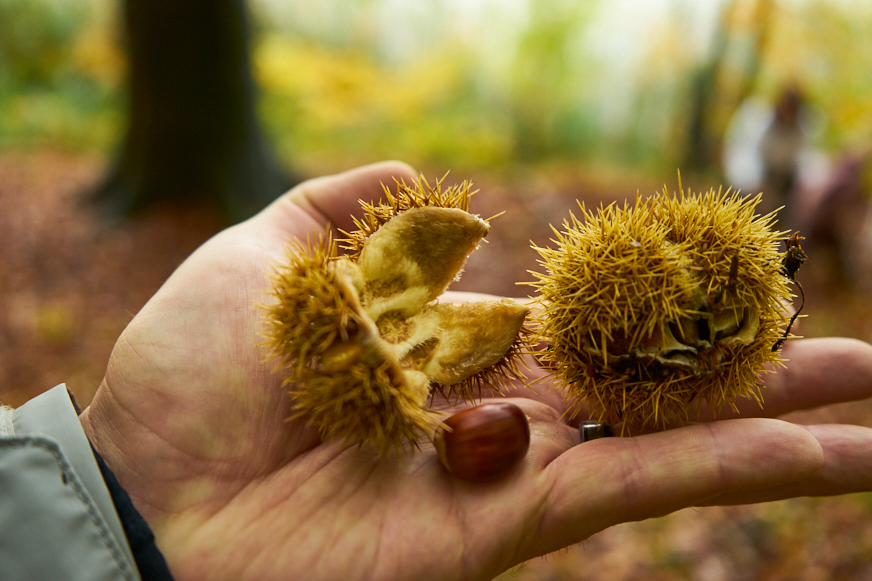
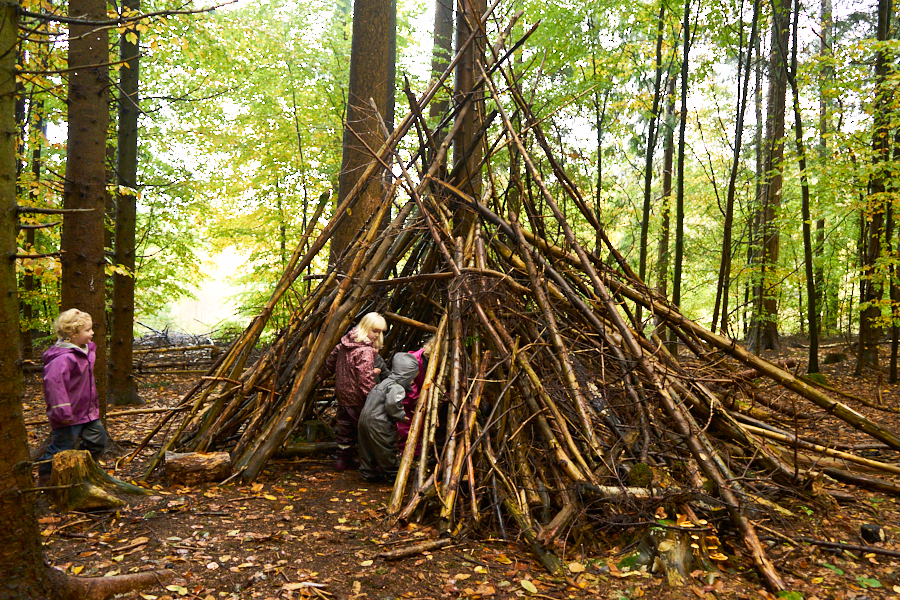
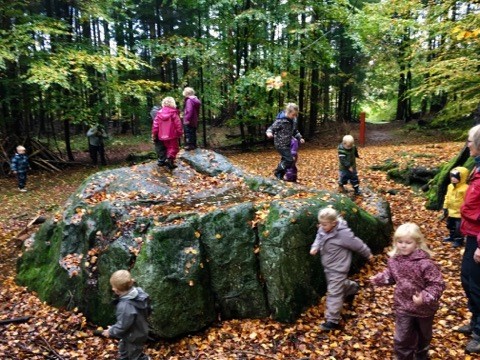
On the way, we will come across trees that have been cut during selective picking to ensure the good health of the forest. Numbers are written on these trunks. At the request of the children, intrigued by these symbols, Lene will stop for a moment to trace and name them with them. Again, a moment of learning that children don’t even realize. It will be the same for those moments when they spontaneously write letters with sticks found on the ground or try to find an object that makes the sound “aaaa “. These little moments of learning are part of everyday life, but are never forced. In Denmark, children under the age of 6 are not considered to have academic knowledge. Of course, we will answer their questions when they have them, we will show how to write their name or even read to a child who wants to, but we do not expect everyone to know when they get there. They will learn it well at that time. Here, we consider that children must learn to live in their bodies, to live in community and to develop their emotional intelligence and dexterity. The rest they will learn quickly when necessary. That said, one of the educators, Kristina Gittesdatter, being very creative on an artistic level, occasionally takes the older ones, those who will return to school that year, with her. They will then spend the day at “home” doing different art projects that will allow them to work on certain skills. Children, who spend most of their time in the woods, always appreciate these special moments.
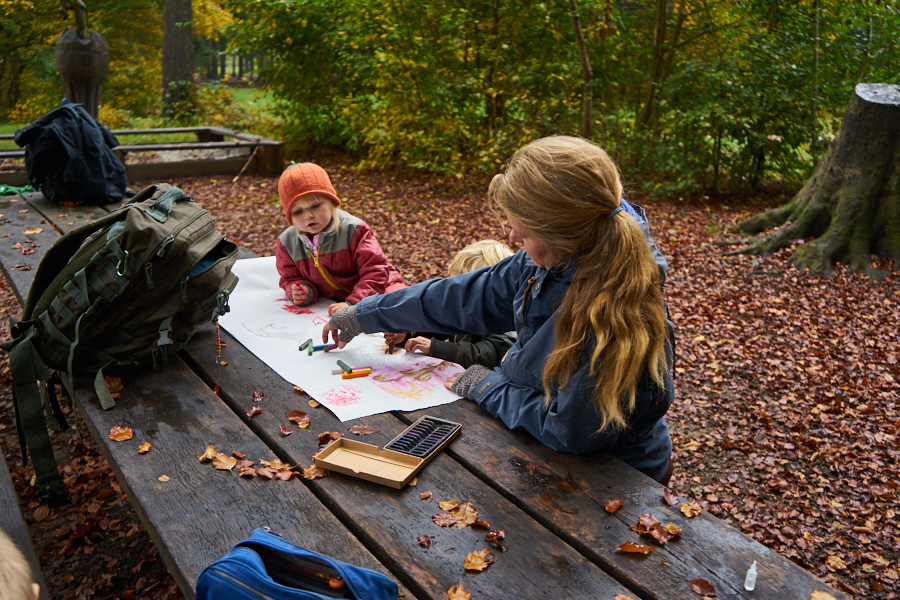
The team of educators, a force for kindergarten
Here, each educator has his strength and it is valued by his colleagues. Kristina is creative and full of new ideas due to the fact that she started only 3 years ago. Lene is great at finding ways to integrate basic learning with children without them noticing, through play. Akke loves making wooden toys and showing children how to use the tools, and Claus is the best for climbing trees. The team is complete and diverse and ensures the success of the kindergarten. Claus will tell me besides that here, he has the impression of being able to be himself and to really offer something to the children, which he missed a lot when he worked in a traditional daycare center where he often faced the judgment of his peers since he dared to think outside the box. They have in common an educational model based on benevolence, trust and respect for each child. One of the kids, for example, has a lot of energy. Akke will explain to me that although in another environment he would have a label, here he is lucky to evolve in an environment that gives him the right to be himself. It is up to them, as educators, to adapt to it and develop tools to help it, not the other way around. He will have time for labels later.

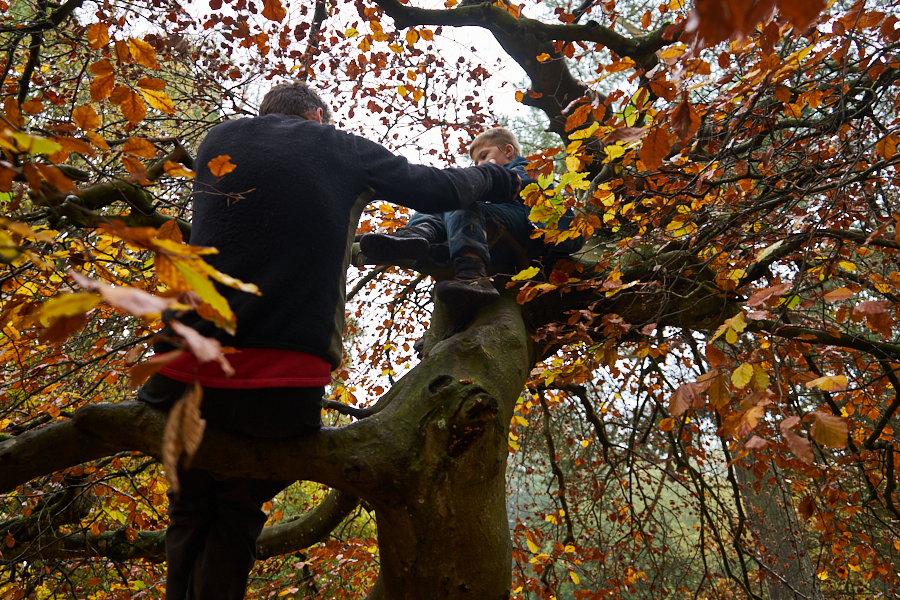
The rest of the day
After the walk, it’s lunch time. Once again, return to the covered shelter. The children take out their dinner and eat it installed where they wish. Educators will then change the diaper of those who have one. The afternoon will unfold calmly, everyone going about their business according to their interests and desires of the day. Educators will intervene only very rarely. Then, around 3 p.m., it will be time to return to the ” house ”. This time, on the bus, we will offer a moment of meditation to the children, because at this age, we know very well that they need rest. Many of them will fall asleep. When they reach their destination, the educators will therefore leave the door of the bus open and as soon as they wake up, the children will leave to join their classmates in the courtyard. Little by little, parents will come to pick up their children, until 5 p.m. when everyone will be back with their family before coming to join their friends the next day with the stars in their eyes!
